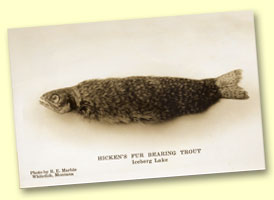 |
|||||
The Fur-Bearing
Trout is a species of fish that possesses a thick coat of fur to keep
itself warm in the cold waters where it lives. These furry fish are primarily
found in the northern regions of North America, but particularly in Canada,
Colorado, Wyoming, and Montana. The species is also sometimes referred
to as the Beaver Trout, or (incorrectly) as the Sabled Salmon. |
According
to legend, the fur-bearing trout was first encountered by Europeans
when Scottish settlers emigrated to Canada during
the seventeenth century. One
of them wrote home remarking about the abundance of "furried animals and
fish" in the new land. Asked to provide more information about the furried
fish, the settler duly sent home a specimen. If true, this legend would pretty
much discredit the Colorado hair-tonic theory of the creature's origin. |
||||
 |
|||||
 |
|||||
| A
number of theories have arisen to explain this creature's luxuriant
coat: • Some say that the creature evolved its thick coat to protect itself from the extreme cold of northern waters. • According to another lesser-known theory, this species of trout owes its fur to four jugs of hair tonic that were accidentally spilled into the Arkansas River (in Colorado) sometime during the 1870s. A few researchers suggest that as the weather grows warmer during the spring the fur-bearing trout sheds its fur, only to regrow its coat as winter returns. This may help explain why trout with full coats of fur are so seldom encountered. |
|||||
| Perhaps the earliest recorded documentation can be found in the May of 1929 issue of Montana Widelife, the Official Publication of the Montana State Fish and Game Department. [CLICK HERE] | |||||
 |
|||||